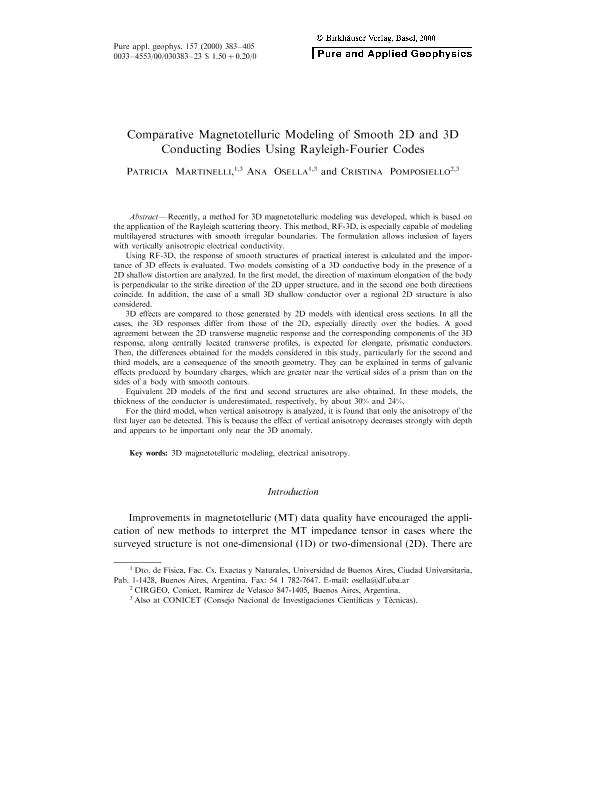Artículo
Comparative magnetotelluric modeling of smooth 2D and 3D conducting bodies using Rayleigh-Fourier codes
Fecha de publicación:
12/2000
Editorial:
Birkhauser Verlag Ag
Revista:
Pure And Applied Geophysics
ISSN:
0033-4553
Idioma:
Inglés
Tipo de recurso:
Artículo publicado
Clasificación temática:
Resumen
Recently, a method for 3D magnetotelluric modeling was developed, which is based on the application of the Rayleigh scattering theory. This method, RF-3D, is especially capable of modeling multilayered structures with smooth irregular boundaries. The formulation allows inclusion of layers with vertically anisotropic electrical conductivity. Using RF-3D, the response of smooth structures of practical interest is calculated and the importance of 3D effects is evaluated. Two models consisting of a 3D conductive body in the presence of a 2D shallow distortion are analyzed. In the first model, the direction of maximum elongation of the body is perpendicular to the strike direction of the 2D upper structure, and in the second one both directions coincide. In addition, the case of a small 3D shallow conductor over a regional 2D structure is also considered. 3D effects are compared to those generated by 2D models with identical cross sections. In all the cases, the 3D responses differ from those of the 2D, especially directly over the bodies. A good agreement between the 2D transverse magnetic response and the corresponding components of the 3D response, along centrally located transverse profiles, is expected for elongate, prismatic conductors. Then, the differences obtained for the models considered in this study, particularly for the second and third models, are a consequence of the smooth geometry. They can be explained in terms of galvanic effects produced by boundary charges, which are greater near the vertical sides of a prism than on the sides of a body with smooth contours. Equivalent 2D models of the first and second structures are also obtained. In these models, the thickness of the conductor is underestimated, respectively, by about 30% and 24%. For the third model, when vertical anisotropy is analyzed, it is found that only the anisotropy of the first layer can be detected. This is because the effect of vertical anisotropy decreases strongly with depth and appears to be important only near the 3D anomaly.
Palabras clave:
3d Magnetotelluric Modeling
,
Electrical Anisotropy
Archivos asociados
Licencia
Identificadores
Colecciones
Articulos(IFIBA)
Articulos de INST.DE FISICA DE BUENOS AIRES
Articulos de INST.DE FISICA DE BUENOS AIRES
Citación
Martinelli, Hilda Patricia; Osella, Ana; Pomposiello, Maria Cristina; Comparative magnetotelluric modeling of smooth 2D and 3D conducting bodies using Rayleigh-Fourier codes; Birkhauser Verlag Ag; Pure And Applied Geophysics; 157; 3; 12-2000; 383-405
Compartir
Altmétricas




